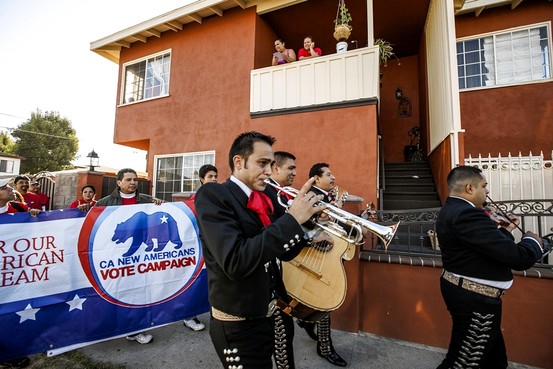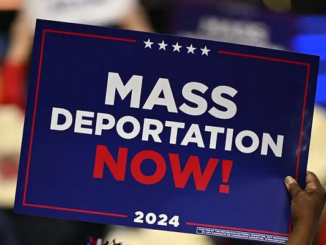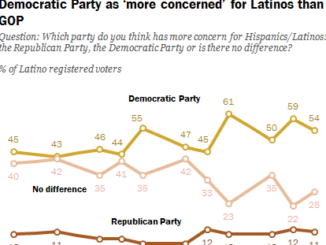
by Neil King Jr.
President Barack Obama’s election victory exposed tectonic demographic shifts in American society that are reordering the U.S. political landscape.
The 2012 presidential election likely will be remembered as marking the end of long-standing coalitions, as voters regroup in cultural, ethnic and economic patterns that challenge both parties—but especially Republicans.
Older voters and white working-class voters, once core elements of the Democratic Party, have drifted into the Republican column. Rural and small-town voters, whose grandparents backed the New Deal, now fill the swath of the U.S. that leans reliably GOP.
But in cities and dynamic suburbs, a rapidly growing force of Latinos, Asian-Americans, African-Americans and higher-income whites emerged this week as the strength of Mr. Obama’s winning Democratic coalition.
“The Democrats now own a coalition of emerging metro areas where the whites and minorities live together, and where they vote Democratic,” said Robert Lang, a demographer who directs the Brookings Mountain West, a research center at the University of Nevada, Las Vegas.
In northern Virginia’s Fairfax County, for example, Democratic Rep. Gerry Connolly represents a district where 20 years ago, he said, 3% of residents were born outside the U.S. Now, it is nearly 30%, with the majority Asian immigrants.
Mr. Obama won big there Tuesday, helping him to tally the once reliably Republican state of Virginia for the second straight general election.
Similar shifts throughout the U.S. help explain how Mr. Obama was returned to the White House on support from young people, minorities, women and upscale whites, a coalition virtually identical to the one that carried him to victory four years ago.
Some political analysts thought that coalition came together only because of the historic nature of Mr. Obama’s 2008 victory and wouldn’t prove durable. That belief didn’t hold up this week.
The question now is whether Mr. Obama and other members of his party can solidify this coalition into a foundation of the Democratic Party.
Republicans said their party won a smashing victory in congressional elections just two years ago, when they took control of the House of Representatives, illustrating that there is no clear claim for either party.
The 2010 election, they said, shows that even with modest inroads among Latino and Asian-American voters, the GOP can build a solid majority on the foundation of its strong white support. Republicans enjoy historically high levels of control over governorships and state legislatures, which they say shows the party’s potential if it can improve its message to minorities.
In any case, both Democrats and Republicans see new contours of a split electorate.
 Twenty years after supporting former President Bill Clinton, a majority of white voters have returned to where they were during the Reagan administration, firmly planted in the Republican camp. Nearly six in 10 white voters told exit pollsters Tuesday that they sided with Republicans, up from 40% during Mr. Clinton’s 1992 presidential victory.
Twenty years after supporting former President Bill Clinton, a majority of white voters have returned to where they were during the Reagan administration, firmly planted in the Republican camp. Nearly six in 10 white voters told exit pollsters Tuesday that they sided with Republicans, up from 40% during Mr. Clinton’s 1992 presidential victory.
More striking is the GOP’s loose grip on minority voters: just 29% of Latinos, 25% of Asians and 8% of African-Americans said Tuesday they identified with the Republican Party.
The trend has strengthened the Democrats’ hold in cities and extended a new reach into once-white suburbs now filling with successful Asian and South Asian immigrants, as well as Hispanics.
Mr. Obama scored a big win, for example, in Denver’s Arapahoe County, a bedroom community of family farms and high-tech firms. The county, in turn, helped propel Mr. Obama to victory for the second time in Colorado, formerly a Republican-leaning state.
The presidential election also cast a spotlight on a generational shift under way.
Senior citizens, who swung to the Democrats during the Medicare and Social Security fights of the 1990s, have swerved to Republicans. Close to six in 10 seniors backed Republican presidential candidate Mitt Romney, according to exit polls Tuesday, up from the 51% of the group siding with Sen. John McCain in 2008.
The split by age reached even deeper: A majority of voters age 40 and older sided with Mr. Romney. The majority of every younger age group voted for Mr. Obama, according to exit polls.
When former President George H.W. Bush, Mr. Reagan and Mr. Clinton won their respective elections, they won among all ages. But no Republican presidential candidate has won a majority of voters under age 30 since Mr. Bush in 1988.
Polls earlier this year showed cooling interest among young voters in the Obama re-election campaign. But turnout among voters ages 18 to 29, in fact, eclipsed the 2008 election, with nearly 60% siding with the president.
The robust turnout by younger voters boosted Democrats nearly as much as the strong showing among Latinos.
Concerns grew Wednesday among some Republicans that the party’s base will be hobbled in national elections if it becomes too old, too rural and too white. “What worries me is that the GOP is about to become the WOP—the White Old Party,” said Norm Coleman, a former Minnesota senator.
Nothing casts more fear in the GOP than estrangement with the swelling U.S. Hispanic population, which now accounts for 10% of the electorate.
During the 1970s and 1980s, Republican presidential candidates routinely received a third or more of the Latino vote. Former President George W. Bush garnered just over 40% in 2004. That share has since plummeted amid sometimes harsh debate over legislation to deal with millions of illegal immigrants, mostly from Mexico, living in the U.S.
Mr. Romney got 29% of the Hispanic vote Tuesday, the lowest share since Sen. Bob Dole ran for president in 1996.
“The party has hit a new floor,” said Al Cardenas, the head of the American Conservative Union and former chairman of the Florida Republican Party. “The reality is we face a very big, very important shifting demographic in the country, and we saw how it played out in Colorado, Florida, Nevada and Virginia.”
Mr. Obama beat Mr. Romney among Latinos by 58% to 40% in Florida; 87% to 10% in Colorado; 80% to 17% in Nevada; and 66% to 31% in Virginia, according to an ImpreMedia/Latino Decisions poll.
“Texas probably has a huge potential to trend Democratic if the Democratic Party engages the electorate there,” said Matt Barreto, co-founder of the Latino Decisions polling firm.
The Romney campaign devoted attention to Asian voters, particularly in northern Virginia. Exit polls showed the Asian vote expanding to 3% of the total U.S. electorate—an all-time high—with 75% of those votes cast for Mr. Obama.
—Arian Campo-Flores contributed to this article.
A version of this article appeared November 8, 2012, on page A1 in the U.S. edition of The Wall Street Journal, with the headline: Vote Data Show Changing Nation.
follow us on facebook and twitter
see full graph of shifting electorate bellow




